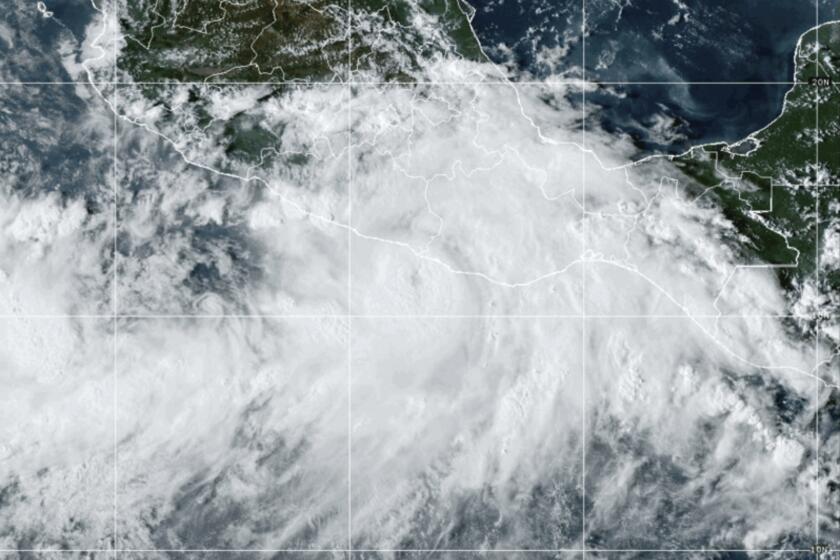Patron of Alaska dies in air crash
Ted Stevens, the temperamental, powerful politician who helped secure statehood for Alaska and won billions of dollars in federal largesse for the region in 40 years as its U.S. senator, died in the crash of a small plane in the rugged, fog-shrouded hills above Bristol Bay in Alaska, authorities said Tuesday.
The crash, which killed five of the nine people on board, critically injured former NASA Administrator Sean O’Keefe and seriously injured O’Keefe’s son Kevin. They were on a fishing trip with Stevens when their single-engine float plane apparently slammed into a low mountainside in high winds, dense clouds and rain.
The crash stunned a state so accustomed to Stevens’ overpowering presence that he was referred to simply as “Uncle Ted.” Even after the loss of his Senate seat after a botched corruption prosecution in 2008, Stevens was a fixture at crucial public events, and Anchorage’s international airport bears his name.
“He built Alaska, he stood for Alaska and he fought for Alaska. Ted was a lion who retreated before nothing,” Alaska Gov. Sean Parnell said at a news conference. “Though small of stature,” Parnell said, the 86-year-old Stevens “seemed larger than life.”
A military transport pilot during World War II, Stevens had survived the 1978 plane crash in Anchorage that killed his wife, Ann, and spent much of his career aboard bush planes flying into remote Alaskan villages with promises of money for sewers, schools and clinics.
As the influential chairman of the Senate Appropriations Committee, Stevens had steered money for airports, hospitals, military bases and universities to the fledgling state. He became the longest-serving Republican senator in history.
Sources in Alaska said Stevens and O’Keefe were longtime friends who were on a fishing trip at an upriver lodge owned by GCI, the Alaska telecommunications company that also owned the downed plane. GCI’s senior vice president, Gregory Chapados, is one of Stevens’ former chiefs of staff.
The company’s rugged but comfortable retreat in the region is a frequent host for political dignitaries and business associates. The region is one of the best-known in the world for sportfishing for salmon, rainbow trout, Dolly Varden and Arctic grayling.
Federal Aviation Administration spokesman Mike Fergus said the DHC-3T Super Otter left Lake Nerka, northwest of Dillingham, Alaska, about 2:15 p.m. Monday bound for a fishing expedition on the Nushagak River.
The plane crashed 17 miles north of Dillingham about 15 minutes after taking off, National Transportation Safety Board Chairwoman Deborah Hersman told reporters.
The wreckage was spotted about 7 p.m. by an overflying plane, and though medics from Dillingham were able to fly in to the site by helicopter Monday night, rescuers from the Alaska Army National Guard and the U.S. Coast Guard were held back by poor weather until Tuesday morning.
Maj. Gen. Thomas Katkus, adjutant general for the National Guard, said, “They pulled four survivors from the wreckage, transported them back to Dillingham, then loaded them on a C-130 [Coast Guard aircraft] for transport to Anchorage.”
The crash occurred near Lake Aleknagik, a Yupik Eskimo word meaning “wrong way home” -- so named because Alaska Natives returning to their homes along the Nushagak River would sometimes get lost in the fog and be swept by the tide up to Lake Aleknagik.
Rick Halford, a longtime pilot and former Republican state legislator who lives nine miles from the crash site, said he was flying near the scene Monday and encountered rain, wind and poor visibility.
“It was just awful weather,” he said. “I came through that valley at about 100 feet off the ground with about a mile of visibility.” He said the point where the plane hit the hillside, at about 1,100 feet of altitude, would have been immersed in clouds.
Killed in the crash in addition to Stevens were Dana Tindall, 48, of Anchorage, a senior vice president for GCI; Tindall’s daughter Corey, 16; Washington lobbyist Bill Phillips, a former Stevens chief of staff; and the pilot, Terry Smith, 62, of Eagle River.
Phillips’ 13-year-old son, Willy, and lobbyist Jim Morhard of Alexandria, Va., were the other two survivors, according to the Alaska State Troopers.
O’Keefe, 54, a former Navy secretary who served as NASA administrator from 2001 to 2005, is chief executive of EADS North America, a subsidiary of the European aerospace company. His injuries included broken bones.
O’Keefe’s son will be a sophomore at Syracuse University.
Stevens spent much of the last two years at his Washington, D.C., home and in Arizona, but came back to his home in Girdwood, Alaska, for key events, such as the funeral of former Gov. Walter J. Hickel in May.
“The thought of losing Ted Stevens ... is too difficult to fathom. His entire life was dedicated to public service,” said Sen. Lisa Murkowski (R-Alaska).
“He truly was the greatest of the ‘Greatest Generation.’ ”
More to Read
Sign up for Essential California
The most important California stories and recommendations in your inbox every morning.
You may occasionally receive promotional content from the Los Angeles Times.










